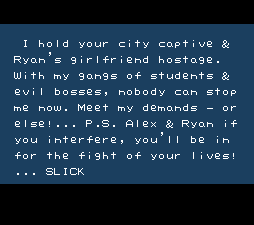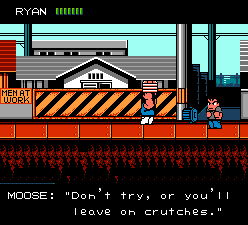 |
River City Ransom - Review |
 |
A Hybrid of Two Genres
By: Robust Stu
| Review Breakdown |
| Battle System |
4 |
| Interface |
6 |
| Music/Sound |
6 |
| Originality |
8 |
| Plot |
2 |
| Localization |
7 |
| Replay Value |
7 |
| Visuals |
4 |
| Difficulty |
Easy |
| Time to Complete |
1-2 hours
|
|
| Overall |
 |
| Criteria
|
One of the most unique games ever released is River City Ransom. It came
out in 1990 for the NES, but due to lack of promotion, was kind of ignored
by the general gaming population at the time. Which is too bad, as although
it didn't really offer anything special graphics, sound, or story-wise, it
had this strange attraction and charm to it that is difficult to ignore.
The plot is very simple. You are either Ryan or Alex (or both, if it's a
two player game). Ryan's girlfriend has been kidnapped by an evil crime
lord by the name of Slick. Slick is holding her hostage in River City High
School, and it's up to Ryan and Alex to go through every thug in town,
defeat Slick, and rescue Ryan's girlfriend. That's really about it, there's
no real plot twists, and most of the conversation is the bosses telling you
that they're going to rearrange your face, or something to that effect.
The battle system is definitely NOT your typical RPG fare. Rather, is is
more your normal Double Dragon style beat 'em up type of game. You walk
down the street, from left to right (for the most part), while bad guys
casually stroll up to you and attempt to feed you a knuckle sandwich. You
have the standard late-80s fighting game moves: punch, kick, and jump kick,
but like RPGs, you have the ability to learn more moves, such as rapid fire
kicking and punching. Your fighting ability, like any RPG, is based on
stats. The stats, UNLIKE RPGs, are not raised by beating opponents for
experience points, but rather by buying items in shops that subsequently
raise your levels upon consumption.

|
| Not the
school you want to send your kids to
|
|
The interface is pretty straightforward, you can check your belongings,
message speed/game difficulty, status, and password. One unique feature
about this game is that the menu has a help option on the menu, where the
game explains each of the other functions on the menu in fair detail. The
password function does not work as well as a battery backup might have, as
the passwords are three lines long, each of which is 11 characters in
length. This caused many problems where people either a)copied the password
down wrong, or b)copied the password down correctly, but it didn't work
anyway, forcing the player to start over from scratch.
There are no side quests in this game. The game is mostly linear, where
once you beat on boss, the next one becomes available to fight, until you
make your way to the final boss. The only really optional parts of the game
are how much you wish to level up, and whether you want to go back and fight
previous bosses later in the game (it's actually kind of a kick to see how
bad you can beat up the earlier bosses once you get ready to tackle the
endgame).
The music is typical NES music, in that you're not going to hear any
sweeping overtures that move you to tears. It is more geared to the
fighting game style than it is to the RPG style. For the most part, it fits
the game. The sound effects are pretty good, however. When you punch or
kick somebody, it sounds like you're REALLY punching or kicking somebody.
The weapons you pick up during the game all have a unique sound when you use
them.
The visuals are pretty simple, you won't find any breathtaking scenery in
this game. Both the characters and the scenery
are big and blocky, which lends a sort of awkward feel to it. Even
considering the time this game came out and the hardware it was designed
for, the graphics aren't anything even remotely special.

|
| Never mess
with guys named Moose |
|
I found this game to be very original, in that it effectively combined
two completely different genres into one. It took the walking down the
street, beating up everybody in sight style found in fighting games with the
levels, money management, and (albeit very simple) storyline. It introduced
us to a totally new, potentially very popular style that unfortunately
hasn't been exploited by anybody else in the ten years since this game's
release.
The people in charge of the localization didn't have much to do. As I
stated above, the only real conversationalists in the game are the bosses,
and even that is extremely limited. One unique thing is that, unlike normal
fighting games where they just blink and disappear when they die, the bad
guys in this game express their displeasure with getting beat up when they
die. Even after ten years, I can't help but laugh out loud when I beat up
some thug, and he says "BARF!" before he gives up the ghost.
This game is pretty short, not much longer than your average non-RPG of
the time, and leans more towards the fighting style than the RPG. Due to
its short length, it is one of those games that you can beat and still want
some more, so you go back and play through it again. Despite the fact that
it's not a particularly pretty game, once you pick it up, it's hard to put
down, so it has definite replay value.
This game can easily be conquered in 2 hours or less, so if you were one
of those people who could play Renegade two or three times a week and not
get tired of it, this game is for you. If you're looking for a 40 hour RPG
which a deep, involved storyline, skip it.
|










